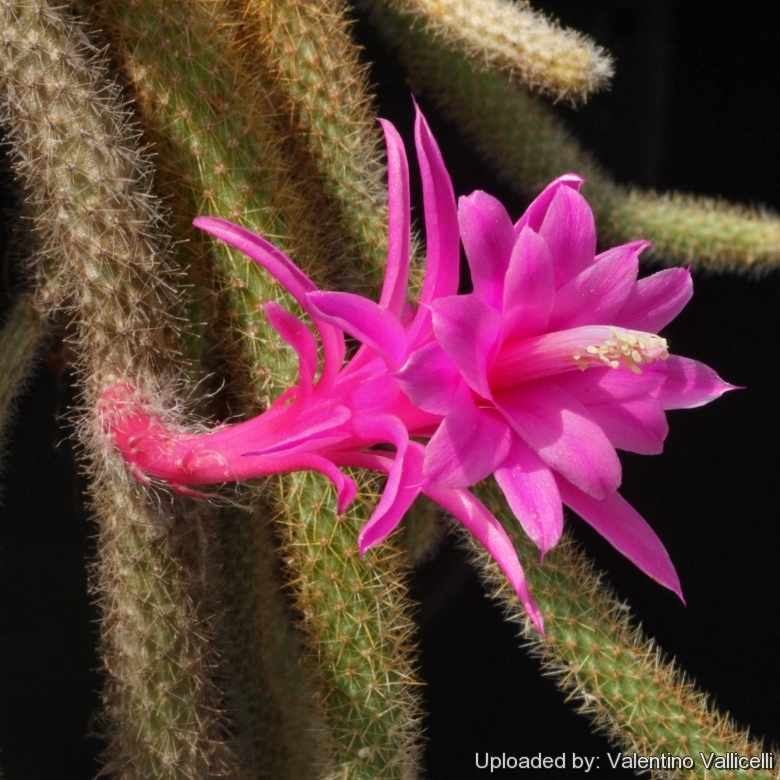
Disocactus flagelliformis Photo by: Valentino Vallicelli
Origin and Habitat: Oaxaca and Hidalgo, Mexico (although suggestions have been made that it might be native of South America), and also reported as wild or naturalized elswhere.
Habitat: Dry forests. Lithophytic or epiphytic in dry forests.
Synonyms:
See all synonyms of Disocactus flagelliformis
Common Names include:
ENGLISH: Rat's Tail Cactus, Whip Cactus, Rattail cactus
FRENCH (Français): Cactus Queue-de-rat, Cactier Queue de Souris, Cierge Serpent, Queue de Rat, Serpentine
GERMAN (Deutsch): Schlangenkaktus
ITALIAN (Italiano): Cactus a Coda di Topo, Coda di Topo
SPANISH (Español): Cola de Iguana, Cola de Rata, Flor de látigo, Flor de cuerno, Floricuerno, Hierba de Alferecia, Junco, Junquillo, Nopalillo, Cactus junco floricuerno
Description: It is a slender, much-branched at base, creeping or epiphytic cactus cultivated as a houseplant for nearly 300 years. It one of the most popular of cacti for its ubiquity in modern collections and home use. The 'Rat's Tail' is also very free-flowering, and its long, slender stems bear multitudes of crimson-pink blooms and makes a good hanging plant. A larger specimen can be quite impressive, tumbling out of a pot, suggesting a waterfall. It is said that it deserves first place among the Cacti of easy culture.
Stem: Slender, vine-like, weak, ascending at first, soon prostrate or pendulous (or climbing), fresh-green later grey-green, terete, up to 1,5(-2) m (or even more) long, round in cross-section about 1-2 cm in diameter.
Ribs: 7-12 Obtuse and inconspicuous, margins ± tuberculate
Areoles: Minute, whitish, close set 4-8 mm apart.
Spines: 9-14(-20), tiny, acicular, bristle-like, reddish brown or reddish yellow, 4-5(-10) mm long.
Flowers: Diurnal, borne laterally, red to purplish-pink usually 5-8(-10) cm long, 2,5-4(-7,5) cm wide, double-sided, symmetrical (zygomorphic) instead of perfectly regular and similar to that of the Christmas cactus Zygocactus truncatusSN|2950]]SN|2950]]), limb bilaterally symmetric, upcurved and slightly oblique, open for 3-5 days, scentless. Pericarpel almost straight greenish with acute bracteoles; receptacle 3 cm, long, curved just above pericarpel, bracteoles, brownish, acute; outer tepals linear-lanceolate, ± reflexed, 2-3 cm long, 6 mm wide, crimson; inner tepals narrowly oblong, to 10 mm wide, crimson, sometimes passing to pink along the margins; stamens white to pale pink, erect, excerted; style stigma lobes 5-7, white
Blooming season: It flowers in mid and late spring and blooms for several days.
Fruit: Globose, 10-12 mm long, 10 mm in diameter, red bristly, pulp yellowish.
Seeds: Ovoid, brownish red.
Remarks: This species, too, has cristate forms.
 Disocactus flagelliformis Photo by: Flavio Agrosi
Disocactus flagelliformis Photo by: Flavio AgrosiSend a photo of this plant.The gallery now contains thousands of pictures, however it is possible to do even more. We are, of course, seeking photos of species not yet shown in the gallery but not only that, we are also looking for better pictures than those already present.
Read More... Cultivation and Propagation: This is probably the easiest species to cultivate and relatively fast growing. A beautiful plant for a hanging basket, this cactus will grow happily in a window. It needs a well drained soil, requires strong sun to part sun. During the growing period the plants need frequent watering; from October to March and waterings should be rather abundant, so that the soil becomes completely soaked, but let dry between watering. Keep relatively dry in winter or when night temperatures remain below 10° C. It is hardy to -4°C for a short period. Assure a good ventilation.
Growing tips: It can be trained on a support, allowed to grow pendant, or grafted onto a straight stem of some other species to produce a beautiful small weeping tree. Older branches over two years old, which become brown and unsightly, can be cut away to the ground without disfiguring the plant.
Propagation: It can be reproduced both by seeds and cuttings. During spring sow seeds in pots and place in gentle warmth. Young seedlings are tiny and they need several years to reach adult size, and require very careful watering. Alternatively, in late spring and early summer take cuttings (allow to dry for week) and insert them in pots filled with a rich cactus-mix and place in gentle warmth.
Traditional uses: The flowers of this species are extensively used medicinally in Mexico. They are sold under the name "flor del cuerno" in the drug markets, for use as a medicine.











